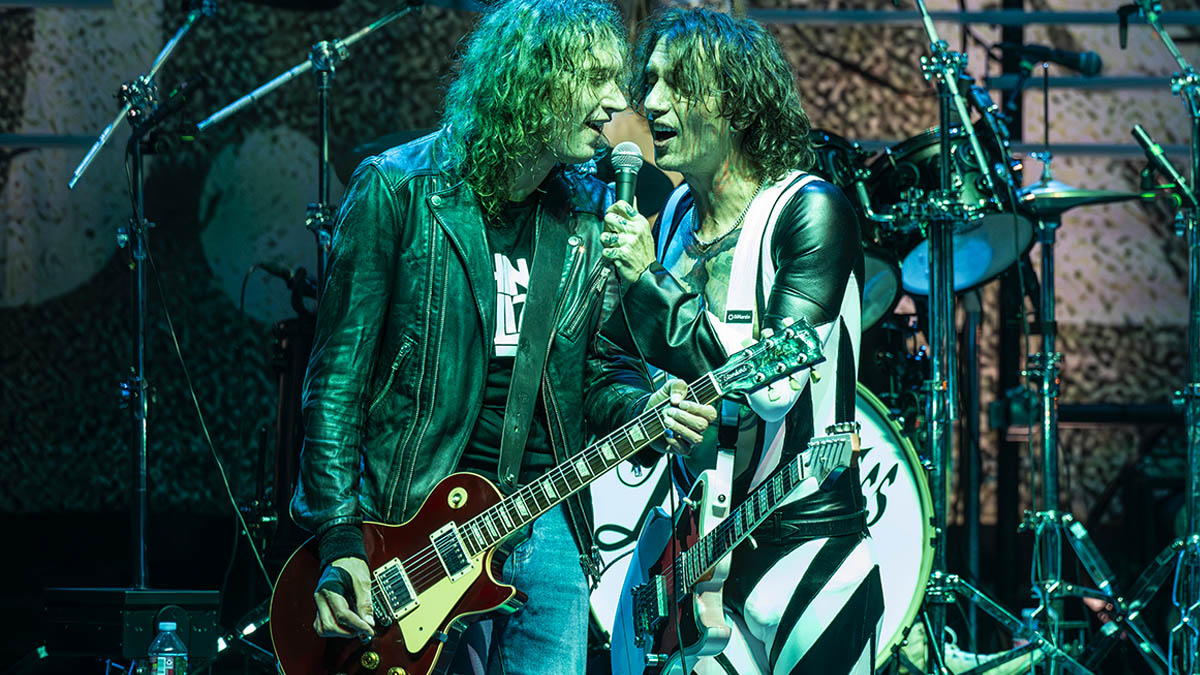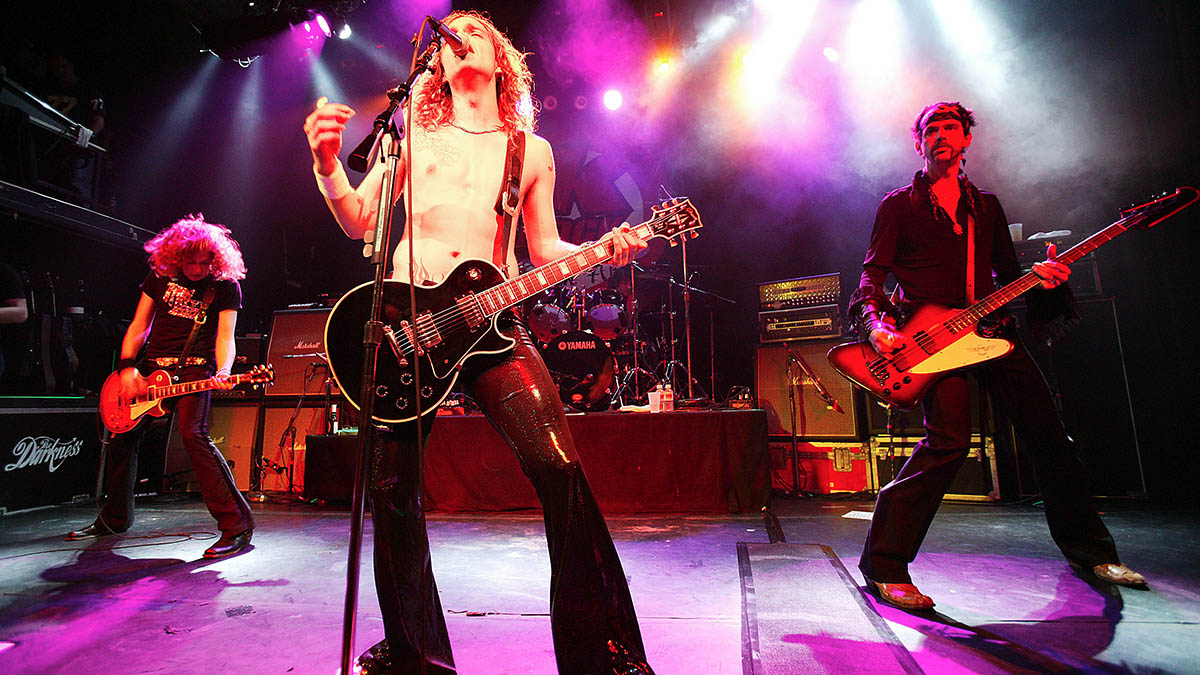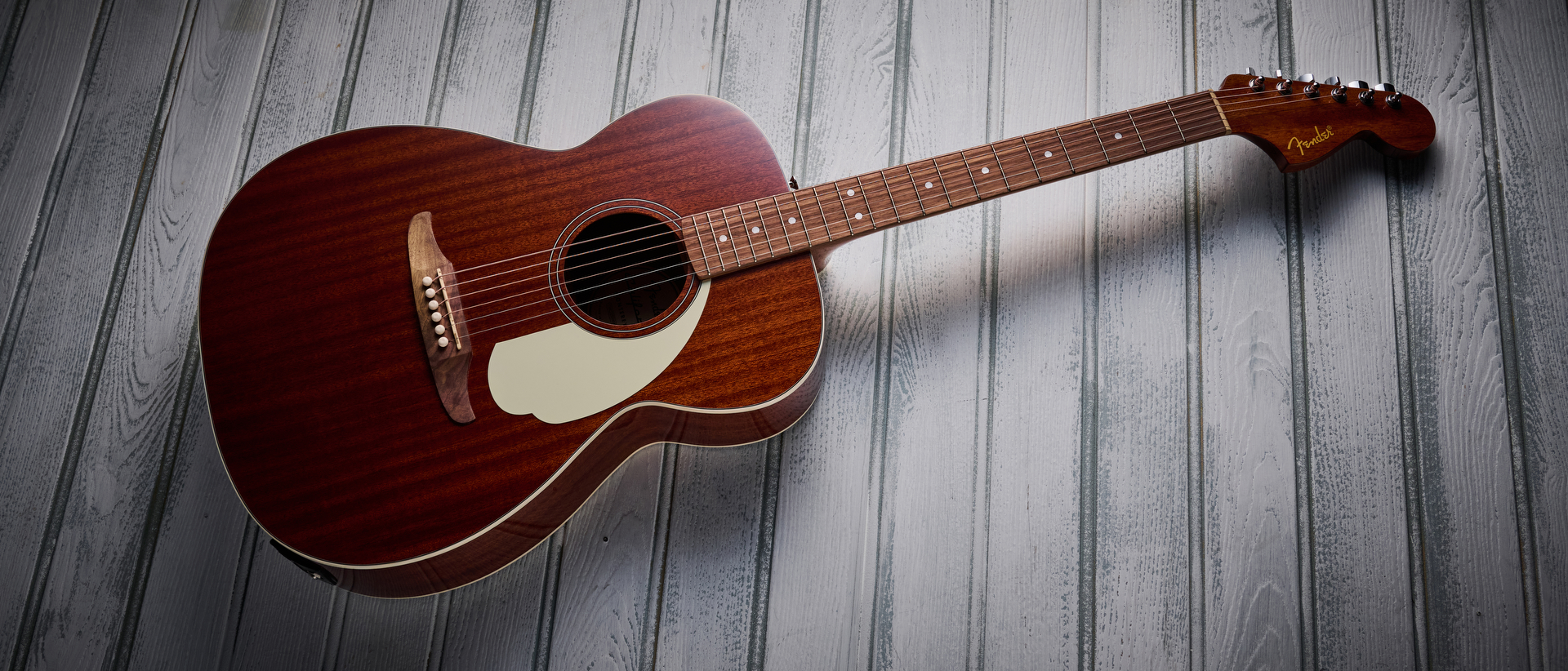“We’re trying to do the AC/DC version of a two-pronged attack, especially when we play live”: The Darkness’ Justin and Dan Hawkins on the high-volume twin-guitar secrets behind Permission To Land
To celebrate 20 years of Permission To Land, the Hawkins brothers take us back to the start, and unpack a sound built upon the elemental force of Marshall amps and Gibson Les Pauls

Every once in a while, a group will come out of nowhere and give rock music the good kick up the arse it desperately needs. In 2003, that band was called The Darkness, and it was their debut album, Permission To Land, that took the sound of Gibson Les Pauls and cranked Marshall amps to the very top of the UK charts.
It is often said the greatest twin-guitar bands – from Thin Lizzy and AC/DC to Aerosmith and Guns N’ Roses – boil down to the chemistry shared between both players, which is something The Darkness have always excelled at.
On stage right, there’s Dan Hawkins, the rhythmic engine and occasional soloist at the very heart of the noise. And centre stage is where you’ll find his older brother Justin, the quartet’s unflinchingly flamboyant singer/guitarist who is typically responsible for their more technical, Eddie Van Halen-inspired leads.
With a newly expanded reissue of the album, Permission To Land… Again, released in October, the siblings join TG for a deep dive through the creative relationship and arena-conquering anthems that helped establish them as one of the most important British rock bands to emerge in the 21st century.
When did it first become apparent you would have different roles when working together musically?
Justin: “Dan and I played in our very first bands together. Dan was either the bass player or the drummer. I guess that would end up being [early band] Vital Signs. We often came as this guitarist and bassist combo. We started playing in a band called Fish Logic, who were already on the circuit and much more established at the time.
“We came as a pair of hired guns to help fill out the sound. The twin guitar thing didn’t start happening until Empire, the band we were in before The Darkness. Dan was playing rhythmic lead guitar filling out all of the parts while I was on keyboards. Towards the end of Empire, I started playing guitar too. It was all about Dan in terms of the core and then in terms of the upper frequencies it was all about me. Wouldn’t you agree with that, Dan?”
All the latest guitar news, interviews, lessons, reviews, deals and more, direct to your inbox!
Dan: “Yeah! I wasn’t a lead guitarist by any means. I was just the rhythm guy. I’d go wherever Justin led really. Because he was older and knew better musicians – and was also a better musician than me – 'twas ever thus! I’d follow him from one band to the next.
“Usually what would happen is someone would get fired and everyone would ask Justin, ‘Do you know anyone?’ and he’d say ‘Well, my brother’s pretty good!’ I think I was given a week’s notice to learn how to play bass for Vital Signs, I’d only played drums until that point. I’ve been blagging my way through ever since!”
What’s the secret to the best twin guitar bands, and which ones helped show you the way?
Justin: “It’s got to be AC/DC. They’re the closest thing to what we’re trying to achieve. Dan is the reliable driving force, the de-facto rhythm machine of the band… very much like Malcolm Young. When I try to play rhythm it’s always very sloppy, but when we get it right, I think my sloppiness accents what Dan is playing.
“We’re trying to do the AC/DC version of a two-pronged attack, especially when we play live. I think Guns N’ Roses are a good example as well. People tend to overlook Izzy Stradlin’s contributions to Appetite For Destruction, but if you listen to one speaker and hear what he’s up to, it’s his work that allows Slash to fly. Who else would you say, Dan? You’re probably going to go with Thin Lizzy, aren’t you?”
Dan: “Yeah! I’d say Lizzy and AC/DC are great examples of how we treat our lead movements. Because I’m not really a technical player by any means. In fact, I only know one scale and Justin taught me that when I was about nine. I never moved on!”
Justin: “It’s the only one I know, too! I’d have shown you others, if I knew ’em…”
You clearly have different skill sets. Is harmonising your leads ever a challenge?
Dan: “When we’re harmonising off the back of one of my solos, it normally sounds like Thin Lizzy and ABBA. And when I’m trying to harmonise with Justin’s solos, you can literally hear me sweating! Especially on Permission To Land, it was a f*cking nightmare. To be honest, the first six years of my career in The Darkness was a nightmare because my G-string was a wound 22.
“So we’d do one of the solos where I have to join in and harmonise, for instance something like Christmas Time (Don’t Let The Bells End), and it would literally be slicing my fingers to pieces. Forget about moving an inch, that G-string wouldn’t be moving a millimetre. Justin loves bending those strings all over the place!”
The first six years of my career in The Darkness was a nightmare because my G-string was a wound 22
Dan Hawkins
Some of your most famous songs like I Believe In A Thing Called Love, Love Is Only A Feeling and Givin’ Up involve trading solos – often with Dan starting. How exactly did that format develop?
Dan: “We call it the ‘Never mind that sh*t, here comes Mongo!’ move! What happens is I’ll start off with a nice melody, something that harks back to yesteryear. And inevitably my solo will run out of steam and then Justin will come in and salvage the piece by harmonising or starting the proper guitar solo. That’s how we do it!”
Justin: “Dan’s stuff tends to be more melodic, especially when we’re operating in the major keys like on I Believe… He ignores the humble blues scale that I showed him and avoids the obvious pentatonic stuff. The main solo starts off with a unison idea on the root and then he starts doing the full descending scale with the major seventh and everything in there.
“It’s posh stuff! Then, at the end, I think it’s still in E major but I start doing bluesy stuff that belongs more in E minor. That’s something Prince used to do a lot. He’d play a solo using the full major scale and then sauce it up with something minor pentatonic stuff afterwards. When you want to put some sauce on your solo, you need the nice bit to put your sauce on top of!”
It’s a very yin and yang kind of relationship, in that sense.
Justin: “I would say so. Or maybe even fire and ice? But who is fire and who is ice?”
Dan: “I’m ice and you’re fire. You bring the raunchiness! The only time I’ll take a solo is when I’ve got a melody in my head, something that helps add to the emotion of the thing. If it makes sense to my ears, then I will put my hand up. And then sometimes I will think, ‘Oh no, I can’t really solo in this key!’ But if I hear something, I will stick my hand up and say, ‘Yes, I will take this section of the song!’”
Dan, on stage it’s always you who does the Jimmy Page-esque lead on Get Your Hands Off My Woman, pulling off on the G and D-strings. Who played it on the recording?
Justin: “That’s Dan! He’s always pulling off his G-string!”
Dan: “That’s my special move and also the name of my autobiography, which comes with a free pair of pants if you preorder… used, of course! There are some songs we know Justin won’t want to be handed a guitar for when we play live. That was definitely one of them. So I figured I’d just do something to get us through…”
Well, it’s always a high point in any live set – especially while Justin is doing his scissor kick handstand!
Justin: “I think Dan tends to play down his lead chops a bit. Sometimes when he takes a solo he won’t restrict himself to any certain scale. He’ll go on these sonic meanderings that leave me scratching my head wondering why he chose those notes. He does things that I can’t imagine doing. We’re both really set in our ways in that sense. But when guitar players go off and experiment, that’s how we learn more about ourselves, and Dan’s really good at that.
“Sometimes he’ll do the solo on the demo just because he’s got a guitar in his hands. Oftentimes, I’ll listen to that and think, ‘Okay, that’s definitely going to be the solo because it’s f*cking awesome!’ He makes some weird choices. Sometimes you’ll only get the freedom to do that when you think it won’t be you doing the solo in the end. So Dan has this knack for stumbling on stuff that makes me think, ‘That’s going to be it!’ because it’s all I want to hear on that song.”

Another thing that sets you apart is your use of delay pedals. Dan, on tracks like Love Is Only A Feeling, Open Fire, and Motorheart, you’ve used the kind of heavy echo that comes from going into an amp’s front end…
Dan: “Do you know where that’s from? Back in the day, with the various bands in London that I was in, there was one Space Echo that got lent around and given to whoever wanted to use it for that week. I completely fell in love with the sound. With a Space Echo you have to go into the front end.
“It’s part of the sound – what happens to your guitar before the amp because of the preamp inside it. That’s why I ended up using that sound a lot. More recently, I have been sticking things in the loop as well, but I still like some delays in the front because it’s part of that Route One sound where the delays are distorting as well.”
So what do you remember about the gear used on Permission To Land?
Justin: “We were both using Les Paul Standards for that first album, actually. Dan was on Dune, which is his number one Les Paul, and I wasn’t using a Custom – I was playing the Black Shuck, which is a black Standard.”
Dan: “There were two phases of recording. For the first one, I was using a 1987x 50-watt Marshall head that our manager bought. I used it for a lot of my parts. It was my first valve amp and I’ve still got it because it sounds so awesome. I absolutely love it. Later on, we basically inherited a bunch of ’90s 100-Watt 1959 Super Leads. So the other half of the album was recorded using those. I think we inherited those amps from The Verve, funnily enough, and I’ve still got a couple of them.
The interesting thing about 'Black Shuck' is that the main rhythms, what you hear Dan playing for the intro, was actually my old Ampeg Dan Armstrong from 1969
Justin Hawkins
“They’re particularly aggressive sounding compared to the other Super Leads I’ve owned over the years. The one we used is still in my studio. Every time I plug it in, it just roars and sounds really in your face. I don’t know why… maybe it’s broken?
“That’s probably what most people are hearing when they think of the rhythm guitar tones. We took it out to Chapel Studios, so it got used on Black Shuck, Givin’ Up, Get Your Hands Off My Woman, and Love On The Rocks With No Ice. It was just dialed in right. We didn’t use any pedals or anything for most of the rhythm sounds.”
Many would say the tone at the beginning of Black Shuck is the very epitome of a classic rock guitar sound…
Justin: “The interesting thing about Black Shuck is that the main rhythms, what you hear Dan playing for the intro, was actually my old Ampeg Dan Armstrong from 1969. It wasn’t a Les Paul on that beginning bit. For my sound I used Mesa/Boogie Dual Rectifiers, because I endorsed them from pretty early on.
“Oh, and Tom Jennings, the Australian actor and musician, lent us this weird thing that let you change the valves in a head to change the sound. It came with a selection of valves that you could pop in to get different tones. Do you remember that, Dan?”
Dan: “I think it was made by THD? And yeah, you could basically hot swap the preamp stage and go between a Marshall or a Vox AC30 and so forth. It was a pretty unusual thing.”
Another fan favourite, Love On The Rocks With No Ice, has a riff that sounds easy but is a lot harder in practice. How did that come about?
Justin: “That main riff kinda evolves through the track. When it gets to Dan’s solo, we started adding passing runs within it. And I’ve started evolving it even further live, but I don’t know if Dan’s ever noticed because his amp is so loud he can’t hear anything else! I’ve started doing this really nasty skanky thing using these Jimmy Page-y kind of major third chords… it changes and then breaks down into some kind of reggae. Whenever I do it, I look over to our tech Ian ‘Softy’ Norfolk and he’s just shaking his head, looking despairingly at me.”
I’m a massive snob when it comes to things that aren’t Gibson, basically. Or really special and vintage. But that Charvel holds its own and sounds f*cking awesome
Dan Hawkins
Justin has been using a Charvel more in recent years. Does that help create some further separation between the two of you?
Dan: “I’m a massive snob when it comes to things that aren’t Gibson, basically. Or really special and vintage. But that Charvel holds its own and sounds f*cking awesome. I can’t believe how much bottom end it has, it’s ridiculous.
Justin: “What I like most about that Charvel is that you can do divebombs on it! That’s always fun. And it’s really good for slide guitar, maybe it has higher action or something. I think it has some Eddie Van Halen electronics in it. There’s some clever stuff happening in there, which is a big part of its overall sound!”
Looking back on your career so far, which songs are you most proud of in terms of capturing your chemistry best? Live ‘Til I Die, Dinner Lady Arms and Rock And Roll Deserves To Die are great examples of using twin guitars to create a very full-sounding wide spread…
Justin: “There are a lot of layers on Rock And Roll Deserves To Die, but it was actually all Dan in the studio. I just did the rock ’n’ roll solo and Strat stuff at the end.”
Dan: “The lead work you did on that is some of your best, actually! It was a Les Paul through an AC30 with a Tube Screamer in front. It ended up sounding really Billy Corgan-esque. I was in full ‘track the hell out of it’ mode on that song via rhythms and mandolins. It came out pretty epic! I’m particularly fond of songs like Givin’ Up and Stuck In A Rut from the first album.
“My job seems to be setting the scene and then Justin comes in and sticks the boot in with a face-melter! I sort of switch the gas on and then Justin ignites it. Then he sticks his head in the oven and we all start slamming it!”
- Permission To Land… Again is out now via Warner Music.
Amit has been writing for titles like Total Guitar, MusicRadar and Guitar World for over a decade and counts Richie Kotzen, Guthrie Govan and Jeff Beck among his primary influences as a guitar player. He's worked for magazines like Kerrang!, Metal Hammer, Classic Rock, Prog, Record Collector, Planet Rock, Rhythm and Bass Player, as well as newspapers like Metro and The Independent, interviewing everyone from Ozzy Osbourne and Lemmy to Slash and Jimmy Page, and once even traded solos with a member of Slayer on a track released internationally. As a session guitarist, he's played alongside members of Judas Priest and Uriah Heep in London ensemble Metalworks, as well as handled lead guitars for legends like Glen Matlock (Sex Pistols, The Faces) and Stu Hamm (Steve Vai, Joe Satriani, G3).









